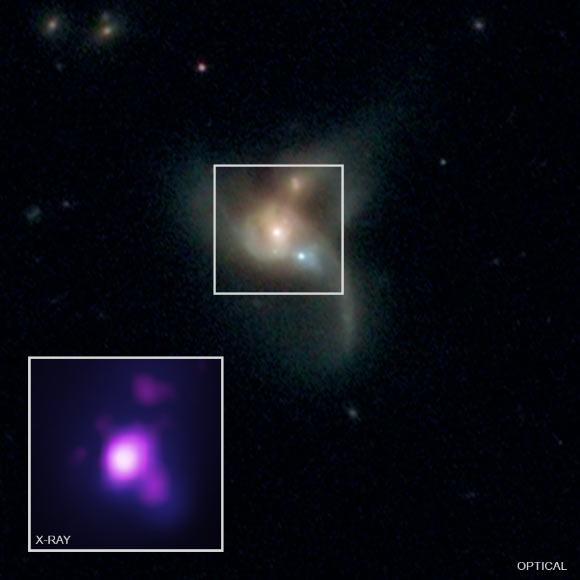Astronomers Find Triple Supermassive Black Hole | Astronomy – Sci-News.com
Using data from several space- and ground-based telescopes, astronomers have discovered a system of three supermassive black holes within SDSS J084905.51+111447.2, a trio of merging galaxies located about one billion light-years from Earth. The discovery is detailed in a paper to be published in the Astrophysical Journal.

Pfeifle et al provide the strongest evidence yet for a system of three supermassive black holes. Image credit: NASA / CXC / George Mason University / R. Pfeifle et al / SDSS / NASA / STScI.
“We were only looking for pairs of black holes at the time, and yet, through our selection technique, we stumbled upon this amazing system,” said George Mason University astronomer Ryan Pfeifle.
“This is the strongest evidence yet found for such a triple system of actively feeding supermassive black holes.”
To uncover this rare trio, Dr. Pfeifle and colleagues analyzed X-ray images from NASA’s Chandra X-ray Observatory and Nuclear Spectroscopic Telescope Array (NuSTAR), infrared images from NASA’s Wide-field Infrared Survey Explorer, and optical light data from the Sloan Digital Sky Survey (SDSS) telescope and the Large Binocular Telescope (LBT).
The Chandra data revealed X-ray sources — a tell-tale sign of material being consumed by the black holes — at the bright centers of each galaxy in the SDSS J084905.51+111447.2 merger, exactly where scientists expect supermassive black holes to reside.
Chandra and NuSTAR also found evidence for large amounts of gas and dust around one of the black holes, typical for a merging black hole system. Meanwhile, data from SDSS and LBT showed characteristic spectral signatures of material being consumed by black holes.
“Optical spectra contain a wealth of information about a galaxy. They are commonly used to identify actively accreting supermassive black holes and can reflect the impact they have on the galaxies they inhabit,” said Dr. Christina Manzano-King, an astronomer at the University of California, Riverside.
“Through the use of these major observatories, we have identified a new way of identifying triple supermassive black holes. Each telescope gives us a different clue about what’s going on in these systems. We hope to extend our work to find more triples using the same technique,” Dr. Pfeifle said.
“Dual and triple black holes are exceedingly rare, but such systems are actually a natural consequence of galaxy mergers, which we think is how galaxies grow and evolve,” said Dr. Shobita Satyapal, of George Mason University.
Three supermassive black holes merging behave differently than just a pair. When there are three such black holes interacting, a pair should merge into a larger black hole much faster than if the two were alone.
This may be a solution to a theoretical conundrum called the ‘final parsec problem,’ in which two supermassive black holes can approach to within a few light-years of each other, but would need some extra pull inwards to merge because of the excess energy they carry in their orbits. The influence of a third black hole could finally bring them together.
“At much larger distances from Earth than SDSS J084905.51+111447.2, when the Universe was younger and galaxy interactions were much more frequent, one can expect that triple galaxy interactions were a common-place occurrence,” Dr. Pfeifle said.
“Therefore, understanding triple supermassive black holes in the local Universe may help us to understand the nature of their more distant counterparts.”
_____
Ryan W. Pfeifle et al. 2019. A Triple AGN in a Mid-Infrared Selected Late Stage Galaxy Merger. ApJ, in press; arXiv: 1908.01732





